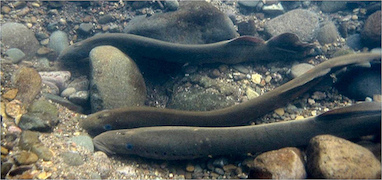Technical Recommendation 12
Lamprey
Conduct research on Pacific lamprey and design artificial propagation strategies to supplement natural production.
Current Status
Pacific lamprey populations continue to decline. Returning adult Pacific lamprey at Bonneville Dam have dropped from an estimated 1 million in the 1950s and 1960s to less than 100,000 over the past decade, including a likely historical low of 6,234 in 2010. See adjacent figure showing the counts of adult Pacific lamprey at Bonneville and McNary dams from 1938-2012. Lamprey declines are even more drastic in the upper Columbia and Snake rivers, where annual adult returns are estimated to be less than 8,000 adults. Despite diminished populations, lamprey remain indispensable to tribal culture—they are essential in First Foods ceremonies and appreciated as a medicinal and nourishing food. Pacific lamprey are vital as well to the biodiversity and ecological services of Columbia River watersheds. Additional information»
Assessment
The original 1995 Spirit of the Salmon hypothesis and recommendations focused on research and follow-up actions on dam passage and related mitigation, including artificial propagation strategies. The tribes continue to believe that although actions need to be taken concurrently to address the many problems facing Columbia Basin lamprey, the single most urgent problem is poor passage for adults and juveniles.
Annual counts of adult Pacific lamprey at Bonneville Dam resumed in 1998 indicating a progressive shift in recognizing these culturally important fish as a management priority. Nonetheless, until the 2008 Columbia Basin Fish Accords, lamprey passage improvements were largely overshadowed by regional emphasis on improving salmon passage to the extent that some improvements for salmon were detrimental to lamprey. In the Accords, the U.S. Army Corps of Engineers committed to spend $5 million annually for lamprey specific passage improvements at its projects. Since the Accords, a variety of operational and structural changes at mainstem hydroelectric dams were made to improve passage for adult lamprey, including the use of multiple lamprey passage structures and extensive modification of entrances and ladders at Bonneville and John Day dams.
In the Accords, the Bureau of Reclamation committed to identifying and developing a plan for its Columbia Basin projects that affect lamprey. Also, the Bonneville Power Administration provided funding for tribally led lamprey projects, including development of a basinwide lamprey restoration plan.
In December 2011, the tribes released the Tribal Pacific Lamprey Restoration Plan (Lamprey Plan) for the Columbia River Basin (CRITFC 2011). The Confederated Tribes of the Umatilla Indian Reservation and the Yakama Nation have developed lamprey restoration approaches for the Umatilla and Yakima rivers, respectively (CRITFC 2011 and Yakama Nation and GeoEngineers 2012).
The current goal of the Lamprey Plan is to immediately halt population declines and prevent further extirpation in tributaries. By 2020 the goal is have annual returns of 200,000 adult lamprey at Bonneville Dam and distribution throughout tribal ceded areas. By 2035 the goal is to have annual returns of 1 million at Bonneville Dam, distribution throughout tribal ceded areas and ample opportunities for tribal harvests to meet ceremonial, medicinal and subsistence needs.
New and Modified Actions
The Lamprey Plan calls for these key actions:
- Improve lamprey mainstem passage, survival and habitat (Lamprey Plan Objective 1).
- Improve tributary passage and identify, protect and restore tributary habitat (Lamprey Plan Objective 2).
- Supplement and/or augment interior lamprey populations by reintroduction and translocation of adults and juveniles into areas where they are severely depressed or extirpated (Lamprey Plan Objective 3).
- Evaluate and reduce contaminant accumulation and improve water quality for lamprey in all life stages (Lamprey Plan Objective 4).
- Conduct research, monitoring and evaluation of lamprey at all life history stages (Lamprey Plan Objective 6).
- Begin implementing components of the Framework for Pacific Lamprey Supplementation Research in the Columbia River.
New institutional actions:
- Establish and implement a coordinated regional lamprey outreach and education program within the region (Lamprey Plan Objective 5).
- Include Pacific lamprey in existing Columbia Basin management and restoration forums and processes established for salmon.
- Increase technical capacity of all federal and state agencies and Federal Energy Regulatory Commission license holders to handle lamprey issues.






